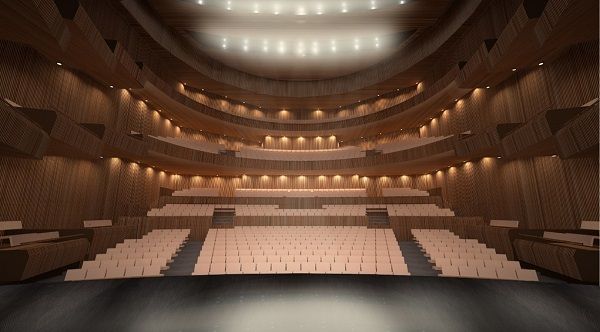When our Development Director Janice Lapwood visited London in July to promote our Waikato transformational projects, she connected with CharcoalBlue, the team behind the design of the Waikato Regional Theatre.
Key amongst them was Elena Giakoumaki, the lead designer of the auditorium now rising out of the ground on the riverside in Hamilton’s CBD.
Here Elena answers our questions about her role in this and her previous projects and the vision for the Waikato’s new world-class performing arts centre.

What other significant theatres and performance spaces have you been involved with designing around the world? What are the major highlights of your career to date?
Being part of a global design consultancy, I have been extremely fortunate to be involved in projects in the UK, mainland Europe, US, Australia and, of course, New Zealand.
One of the major highlights must be the refurbishment of the Dorfman Theatre (née Cottesloe), the spirited small sibling of the National Theatre’s two larger stages. The Dorfman theatre is a seminal flexible courtyard space which has been a point of reference for countless intimate theatrical spaces in the UK and around the world. Having many memorable experiences as a punter myself, the opportunity to rethink this iconic space has been nothing short of a rare privilege.
Other major highlights are the remodelling of the Grade One-listed Theatre Royal Drury Lane, the design of the ultra-flexible Soho Place (the first new-build London West End theatre in 50 years!) as well as Chicago Shakespeare Theater, and more recently the vibrant Geelong Arts Centre’s Open House.
Of the various theatres and auditoriums you have been involved in designing, what stands out for you about the brief and then the final design of the Waikato Regional Theatre?
Waikato Regional Theatre had an ambitious brief – a multipurpose lyric theatre designed equally for music, drama, dance and community functions - a world-class facility for a vibrant local community.
I think that what will stand out in the Waikato Regional Theatre is that despite being a large 1,300 seat auditorium, it will have the sense of intimacy, energy and connection typically achieved in much smaller spaces. The design carefully wraps the audience around the performance area in all dimensions, achieving the sense of focus and intensity the shared experience of live performance is all about.
Similarly, where do you think the new Waikato Regional Theatre sits within the realm of theatre design around the world?
The Waikato Regional Theatre will no doubt sit among the select ranks of world-class auditoria. But while it will share similar qualities in functionality, flexibility, acoustic and technical performance, it has been shaped by the community it will be serving, designed as a response to their vision, wishes and cultural aspirations.

Do you have any particular memories or stories about your experience of designing the Waikato Regional Theatre, especially around accommodating the feedback from the community consultation that took place?
What the community asked for was a theatre to be proud of, a facility that would not only secure Hamilton’s place on the world’s cultural map, but also where home-grown talent can create, experiment, present and celebrate, setting high standards for the present and aspiring to nothing but the best for the future.
So, although the Theatre has the capacity to receive large-scale touring productions, its scale, design and location right in the heart of Hamilton will inspire a sense of ownership and familiarity akin to a contemporary and sophisticated village hall for the community.
What do you hope and expect the public and the performers of Waikato and New Zealand to gain from the Waikato Regional Theatre? What has been the cultural, social and economic impact of the other theatres you’ve been involved in bringing into existence?
The impact of such a centrally located major capital cultural project to the surrounding community cannot be understated. More than the immediate social and economic impact such projects have by creating jobs, boosting local businesses and placing the entire city’s cultural offer at a different level altogether, the long-lasting effects are equally important.
They become a point of reference for entire generations that grow up with such a facility at their doorstep, where they not only get to experience world-class artists, but have a chance to learn, create and present on the same stage themselves. More than a place of entertainment, a theatre is where the richness, diversity, vulnerability and power of being human is deeply felt and celebrated.
What’s it like working for Charcoalblue? What other great projects are you and/or the company working on and expecting to go live in the next while?
There’s never a dull moment! Every project is different – every client, every brief, every community the building is serving.
And this is the exciting part, the feeling that as a company and as individuals we have a chance at making a positive impact, and all while doing what we love - what else can anyone ask for?
We have just completed two iconic projects, Aviva Studios in Manchester and the Perelman Centre in New York, two very different, high-profile projects, but both set to put their stamp not just on their local but the global cultural arts landscape.
We have a number of projects of all scales in the design and construction stages at the moment, and we are as proud of the small ones which humbly serve and nurture their community as much as the larger high-profile projects.
